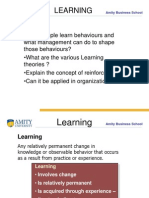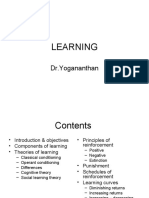0 ratings0% found this document useful (0 votes)
31 viewsOrganisational Behaviour: LEARNING Class: 2P3BBM Lecturer: Lazarus Machevele June 5, 2020
Organisational Behaviour: LEARNING Class: 2P3BBM Lecturer: Lazarus Machevele June 5, 2020
Uploaded by
Layway McDonaldThe document discusses learning in organizational behavior, defining it as a permanent change in behavior resulting from experience, and outlining several theories of learning including classical and operant conditioning, cognitive learning, and social learning. It also covers strategies for reinforcing behaviors through positive and negative reinforcement as well as punishment and extinction.
Copyright:
© All Rights Reserved
Available Formats
Download as PPTX, PDF, TXT or read online from Scribd
Organisational Behaviour: LEARNING Class: 2P3BBM Lecturer: Lazarus Machevele June 5, 2020
Organisational Behaviour: LEARNING Class: 2P3BBM Lecturer: Lazarus Machevele June 5, 2020
Uploaded by
Layway McDonald0 ratings0% found this document useful (0 votes)
31 views21 pagesThe document discusses learning in organizational behavior, defining it as a permanent change in behavior resulting from experience, and outlining several theories of learning including classical and operant conditioning, cognitive learning, and social learning. It also covers strategies for reinforcing behaviors through positive and negative reinforcement as well as punishment and extinction.
Original Title
OB iii.pptx
Copyright
© © All Rights Reserved
Available Formats
PPTX, PDF, TXT or read online from Scribd
Share this document
Did you find this document useful?
Is this content inappropriate?
The document discusses learning in organizational behavior, defining it as a permanent change in behavior resulting from experience, and outlining several theories of learning including classical and operant conditioning, cognitive learning, and social learning. It also covers strategies for reinforcing behaviors through positive and negative reinforcement as well as punishment and extinction.
Copyright:
© All Rights Reserved
Available Formats
Download as PPTX, PDF, TXT or read online from Scribd
Download as pptx, pdf, or txt
0 ratings0% found this document useful (0 votes)
31 views21 pagesOrganisational Behaviour: LEARNING Class: 2P3BBM Lecturer: Lazarus Machevele June 5, 2020
Organisational Behaviour: LEARNING Class: 2P3BBM Lecturer: Lazarus Machevele June 5, 2020
Uploaded by
Layway McDonaldThe document discusses learning in organizational behavior, defining it as a permanent change in behavior resulting from experience, and outlining several theories of learning including classical and operant conditioning, cognitive learning, and social learning. It also covers strategies for reinforcing behaviors through positive and negative reinforcement as well as punishment and extinction.
Copyright:
© All Rights Reserved
Available Formats
Download as PPTX, PDF, TXT or read online from Scribd
Download as pptx, pdf, or txt
You are on page 1of 21
UNIVERSITY OF ST.
THOMAS OF MOZAMBIQUE
BUSINESS SCHOOL
Organisational Behaviour: LEARNING
Class: 2P3BBM
Lecturer: Lazarus Machevele
June 5, 2020
Objectives
• Define learning
• Characteristics and features and learning
• Learning vs Training- students to look and
discuss on their own as agreed.
• Theories of Learning
• Strategies of reinforcement
LEARNING
• Learning is any permanent change in
behaviour of a person that occurs as result of
experience. It is accompanied by acquisition of
knowledge, skills & expertise which are
relatively permanent
FEATURES OF LEARNING
1) Learning involves change in behaviour of a person :
The change may be good or bad from organisation’s
point of view. For example : bad habits, prejudice,
etc may be learnt by an individual.
2) Change in behaviour must be relatively permanent :
To constitute learning, change should be relatively
permanent. Temporary changes may be only
reflective and fail to represent any learning . This
rules out behavioural changes caused by fatigue or
drugs.
Features of Learning Cont’d...
3) The change in behaviour should occur as a result of
experience, practice or training: It implies that
behaviour caused from maturity, disease, or physical
damages does not constitute learning.
4) The practice or experience must be reinforced in
order for learning to occur: If reinforcement does not
accompany the practice or experience, the behaviour
will eventually disappear.
5) Learning is reflected in behaviour : A change in an
individual’s thought process or attitudes, not
accompanied by behaviour, is no learning.
Features of Learning Cont’d
• Learning must be reinforced : In organisations,
both positive & negative reinforcements should be
used.If behaviour is undesirable, the negative
reinforcement such as denial of a pay raise,
promotion or transfer can be effective. However,
during the orientation & training period, positive
reinforcement is more effective than negative
reinforcement
THEORIES OF LEARNING
• There are 4 theories which explain how
individuals learn new patterns of behaviour :
• Behaviourist- classical & operant Conditioning
• Cognitive
• Social learning
• Constuctivism- we will talk of these two in detail later
• Experiential Learning
Theories of learning Cont’d...
CLASSICAL CONDITIONING
• Classical Conditioning deals with the association of one event with another
desired event resulting in a desired behaviour or learning.
• Classical conditioning was given by Ivan Pavlov, a famed Nobel prize winning
physiologist.
• Pavlov conducted an experiment on a dog to study the relation between the
dog’s salivation & ringing of a bell. When he presented a piece of meat to the
dog, he noticed a great deal of salivation. He called the food as unconditioned
response. During the second stage, he merely rang the bell, but the dog did not
salivate in response to ringing of the bell. He subsequently introduced the
sound of the bell each time the meat was given to the dog. Thus, eventually the
dog learnt to salivate in response to the ringing of the bell even when there was
no meat. This is how Pavlov conditioned the dog to respond to a learned
stimulus.
OPERANT CONDITIONING
• Operant conditioning is based on the work of B.F. Skinner. It is based on the
premise that behaviour is a function of its consequences.
• Individuals emit responses that are rewarded & will not emit responses that are
either not rewarded or are punished. Behaviour is likely to be repeated if the
responses are favourable & it is not likely to be repeated if the consequeces are
unfavourable.
• Operant conditioning is a powerful tool for people in the organisations. Most
behaviours in organisations are learned, controlled & altered by consequences.
• Management can use this process to control & influence the behaviour of
employees by manipulating the reward system. Thus, behavioural consequences
that are rewarding increase the rate of response , while the aversive
consequences decrease the rate of response.
COGNITIVE LEARNING
• Cognition refers to an individual’s ideas,
thoughts, knowledge, interpretations,
understandings, etc about himself & his
environment.
• The theory states that when people observe a
model performing a behavior and the
consequences of that behavior, they remember
the sequence of events and use this
information to guide subsequent behaviors.
SOCIAL LEARNING
• Social learning theory is extension of operant
conditioning
• The view that we can learn through both
observation and direct experience is called
social learning
SHAPING BEHAVIOUR
• In any organisation, managers are concerned with making their subordinates
learn those behaviours that are most beneficial to the organisation. When a
manager moulds individuals by guiding their learning, he is shaping behaviour.
• THE LAW OF EFFECT : The operant conditioning is based on the law of effect
propounded by Thorndike. The law states that the behaviour that has rewarding
consequence is likely to be repeated, whereas the behaviour that leads to
negative consequences tends not to be repeated.
• Example : If Employees work hard to achieve organisational objectives & are
directly rewarded with bonus , they will tend to repeat their efforts when new
objectives are set.
SRATEGIES OF
REINFORCEMENT
• Reinforcement may be defined as anything
that both increases the strength of response
and tends to induce repetitions of the
behaviour that preceded the reinforcement.
Positive reinforcement
• Positive reinforcement is a reward or other
desirable consequence that follows a particular
behaviour or activity. Its used to increase the
frequency of action or behaviour.
Negative reinforcement
• Negative reinforcement takes place when
individuals learn to escape or avoid from
unpleasant consequences. For example :
people learn to drive carefully to avoid
accidents.
PUNISHMENT
• Punishment is a means of reducing a desired
behavior by introducing a potentially
undesirable consequence.
• For e.g. salary cuts, termination, loss of
privileges and layoffs.
EXTINCTION
• Extinction is an effective method of controlling
undesirable behaviour. It is based on the
principle that if a response is not reinforced, it
will eventually disappear.
• For example : A disruptive employee who
fights & is punished by the supervisor for doing
so may continue the disruptions because of
the attention they bring. By ignoring the
employee, attention is withheld & also the
motivation for fighting.
Questions
Assignment
• Behaviour is a function of its consequences.
Discuss. (20 marks.
You might also like
- Kelley 1950Document10 pagesKelley 1950George Demetru LadimaNo ratings yet
- According To Stephen Robbins, Learning May Be Defined As Any Relatively PermanentDocument19 pagesAccording To Stephen Robbins, Learning May Be Defined As Any Relatively PermanentMuralidhar CVNo ratings yet
- ICE 9 Grid ModelDocument6 pagesICE 9 Grid Modelpavan bhogeNo ratings yet
- Holcomb Chapter 2Document15 pagesHolcomb Chapter 2api-244761274100% (1)
- Audiovisual Method: Theoretical AssumptionsDocument5 pagesAudiovisual Method: Theoretical AssumptionsValeska ManéNo ratings yet
- Organisational Behaviour: LEARNING Class: 2P3BBM Lecturer:: Business SchoolDocument21 pagesOrganisational Behaviour: LEARNING Class: 2P3BBM Lecturer:: Business SchoolLayway McDonaldNo ratings yet
- Topic: Components and Determinants of Learning and Principles of ReinforcementDocument30 pagesTopic: Components and Determinants of Learning and Principles of ReinforcementSuraj JayNo ratings yet
- 2 LearningDocument14 pages2 LearningSanjeev ShettyNo ratings yet
- Learning: Amity Business SchoolDocument24 pagesLearning: Amity Business SchoolTannawy SinhaNo ratings yet
- LearningDocument29 pagesLearningneetaNo ratings yet
- The Learning Process: Definition and Perspective of LearningDocument40 pagesThe Learning Process: Definition and Perspective of LearningMarjorie Ventuales Libo-on100% (1)
- Unit 2 LearningDocument26 pagesUnit 2 Learningwitnesschirombo3No ratings yet
- Foundation of Individual BehaviorDocument6 pagesFoundation of Individual BehaviorKumkum SultanaNo ratings yet
- Behavioural TheoryDocument54 pagesBehavioural Theorymtileinge01No ratings yet
- Reinforcement Theory of MotivationDocument10 pagesReinforcement Theory of MotivationMuhammad AkhtarNo ratings yet
- Module-3 OB 1st Sem - VsDocument15 pagesModule-3 OB 1st Sem - VsVinu VaviNo ratings yet
- Report On SynopsisDocument34 pagesReport On Synopsistravi4993No ratings yet
- Approaches To Counseling II - 1Document77 pagesApproaches To Counseling II - 1Chawla KaurNo ratings yet
- Learning: Any Relatively Permanent Change in Behavior That Occurs As A Result of ExperienceDocument11 pagesLearning: Any Relatively Permanent Change in Behavior That Occurs As A Result of ExperienceMohit DadhichNo ratings yet
- Unit 2 (Part 3) (Learning)Document26 pagesUnit 2 (Part 3) (Learning)2004meghamishraNo ratings yet
- Behaviour TheoryDocument27 pagesBehaviour Theoryrishirajbal9710No ratings yet
- LEARNINGDocument4 pagesLEARNINGViswajeet RayNo ratings yet
- Learning: DR Musarrat ShaheenDocument28 pagesLearning: DR Musarrat ShaheenAyushi YadavNo ratings yet
- Management and Organizational BehaviourDocument6 pagesManagement and Organizational BehaviouriqmobiletutorNo ratings yet
- LearningDocument17 pagesLearningNavjot SidhuNo ratings yet
- Learning & Behavior ReinforcementDocument14 pagesLearning & Behavior Reinforcementreach_to_rahulNo ratings yet
- unit6-MB 0001Document23 pagesunit6-MB 0001yogaknNo ratings yet
- Individual Behavior and LearningDocument30 pagesIndividual Behavior and Learning9861296147No ratings yet
- Nature An Scope of HRDDocument47 pagesNature An Scope of HRDRara Alonzo50% (2)
- Edu Topic 4 Behaviourist TheoryDocument3 pagesEdu Topic 4 Behaviourist TheoryYaya CasablancaNo ratings yet
- Unit 4 Learning Smita Choudhary Faculty HR/OBDocument30 pagesUnit 4 Learning Smita Choudhary Faculty HR/OBsmita choudharyNo ratings yet
- Unit - 4 LearningDocument17 pagesUnit - 4 LearningSujan BhattaraiNo ratings yet
- Behavioral and Social Cognitive Perspectives and Approaches: Samantha Baylon Allen Beato Rafael Ferrer Marvin RiveraDocument36 pagesBehavioral and Social Cognitive Perspectives and Approaches: Samantha Baylon Allen Beato Rafael Ferrer Marvin RiveraAllen BeatoNo ratings yet
- Behavioural Theories of LearningDocument28 pagesBehavioural Theories of Learninghot chocoNo ratings yet
- Behavioural TherapyDocument14 pagesBehavioural TherapyNITIN RAWATNo ratings yet
- 01 Learning and Shaping BehaviourDocument30 pages01 Learning and Shaping BehaviourAyush JainNo ratings yet
- ORBR TCEL - Session 1 PDFDocument27 pagesORBR TCEL - Session 1 PDFharsha_295725251No ratings yet
- Individual Learning and Behavior-PsychologyDocument35 pagesIndividual Learning and Behavior-PsychologyAyushNo ratings yet
- Topic 5 Behaviorism UpdatedDocument52 pagesTopic 5 Behaviorism UpdatedYawai ThethninNo ratings yet
- BehaviorismDocument34 pagesBehaviorismFlorabel HilarioNo ratings yet
- Chapter Three: Learning and Theories of LearningDocument37 pagesChapter Three: Learning and Theories of LearningOROM VINENo ratings yet
- LearningDocument42 pagesLearningJaya PradeepNo ratings yet
- LearningDocument24 pagesLearningRagnar LothbrokNo ratings yet
- Operant Conditioning, Social Learning and Its Applications On PathologyDocument3 pagesOperant Conditioning, Social Learning and Its Applications On PathologyAvantika PvNo ratings yet
- Behavior Modification TechniquesDocument34 pagesBehavior Modification Techniquesnimfa salveNo ratings yet
- Foundations of Individual BehaviorDocument30 pagesFoundations of Individual Behaviorgauravgpt17No ratings yet
- Lecture#7Document38 pagesLecture#7Arshiyan ParachaNo ratings yet
- Certi 202210110547Document5 pagesCerti 202210110547Vinod RanaNo ratings yet
- Module III Learning Class NotesDocument31 pagesModule III Learning Class Notestikesh sahuNo ratings yet
- Sppp1012 Week 4Document32 pagesSppp1012 Week 4eidalinNo ratings yet
- Module 3 Learning, Perception and AttributionDocument60 pagesModule 3 Learning, Perception and AttributionMarjon DimafilisNo ratings yet
- Two Models of Workplace StressDocument2 pagesTwo Models of Workplace StressMarjorie RiveraNo ratings yet
- OB BBE5 Unit2 A Learning Attitude Job SatisfactionDocument64 pagesOB BBE5 Unit2 A Learning Attitude Job SatisfactionKeshav AroraNo ratings yet
- Behaviour TherapyDocument32 pagesBehaviour TherapySalman MajidNo ratings yet
- Module 6Document7 pagesModule 6erikalombardo8No ratings yet
- Learning ConceptDocument16 pagesLearning ConceptPradeep PadiamiNo ratings yet
- Learning in An OrganizationDocument42 pagesLearning in An OrganizationSahilNo ratings yet
- Learning and ThinkingDocument42 pagesLearning and ThinkingEmz JoseNo ratings yet
- Organisational_Behaviour-Session_5_Prof._Alpha_Weekday_Slow_Track_5o6mfudiSBDocument45 pagesOrganisational_Behaviour-Session_5_Prof._Alpha_Weekday_Slow_Track_5o6mfudiSBdeepak manktalaNo ratings yet
- Differential Reinforcement - FinalDocument5 pagesDifferential Reinforcement - FinalAli Aman QaisarNo ratings yet
- LearningDocument13 pagesLearningRadHika GaNdotraNo ratings yet
- HRMT 3113Document5 pagesHRMT 3113Layway McDonaldNo ratings yet
- MSC Human Resource Management Cohort: Mhrm/13/Pt Aug Examinations For 2013 - 2014 Semester Ii / 2014 Semester IDocument3 pagesMSC Human Resource Management Cohort: Mhrm/13/Pt Aug Examinations For 2013 - 2014 Semester Ii / 2014 Semester ILayway McDonaldNo ratings yet
- HRMT 3113Document3 pagesHRMT 3113Layway McDonaldNo ratings yet
- BSC (Hons) Human Resource Management (Top-Up)Document4 pagesBSC (Hons) Human Resource Management (Top-Up)Layway McDonaldNo ratings yet
- Toilet Construction Handbook For MasonsDocument24 pagesToilet Construction Handbook For MasonsLayway McDonaldNo ratings yet
- HB-189-18 HC 204-18 CLAUDIUS MANMEL & 2 OTHERS Vs ROSEWELL ZULU & 3 OTHERS MABHIKWA JDocument7 pagesHB-189-18 HC 204-18 CLAUDIUS MANMEL & 2 OTHERS Vs ROSEWELL ZULU & 3 OTHERS MABHIKWA JLayway McDonaldNo ratings yet
- Dear Class of 2020 Students and Families LetterDocument1 pageDear Class of 2020 Students and Families LetterLayway McDonaldNo ratings yet
- A) Workforce Diversity B) Cross-Cultural Dynamics C) Individual Behaviour D) Individual Difference E) Values and AttitudesDocument14 pagesA) Workforce Diversity B) Cross-Cultural Dynamics C) Individual Behaviour D) Individual Difference E) Values and AttitudesLayway McDonaldNo ratings yet
- Introduction To Strategic Human Resource ManagementDocument35 pagesIntroduction To Strategic Human Resource ManagementLayway McDonaldNo ratings yet
- Learning Theories of LearningDocument10 pagesLearning Theories of LearningLayway McDonaldNo ratings yet
- Final Lesson Plan - Living Vs Nonliving ThingsDocument3 pagesFinal Lesson Plan - Living Vs Nonliving Thingsapi-315487341100% (3)
- Module 3 Study Guide 2013Document5 pagesModule 3 Study Guide 2013Alli Whitener0% (7)
- Introduction On Inquiry-Based Learning (IBL) : Project NameDocument8 pagesIntroduction On Inquiry-Based Learning (IBL) : Project Namecekgu danieNo ratings yet
- Reading 01 - Finn - 2020 - What Is Critical RealismDocument10 pagesReading 01 - Finn - 2020 - What Is Critical RealismmoennfNo ratings yet
- Portfolio Lesson Plan Analysis and ReflectionDocument2 pagesPortfolio Lesson Plan Analysis and Reflectionapi-292337013100% (1)
- Vygotsky's Educational Theory in Cultural Context: Edited byDocument0 pagesVygotsky's Educational Theory in Cultural Context: Edited byInês SaraivaNo ratings yet
- Lesson Plan 1 Vocab Mnemonics and PrefixesDocument3 pagesLesson Plan 1 Vocab Mnemonics and Prefixesapi-253551897No ratings yet
- Machiavelli and His Influence On Modern International Law Victory Goes To The Swift, The Strong, and Sometimes, The RuthlessDocument86 pagesMachiavelli and His Influence On Modern International Law Victory Goes To The Swift, The Strong, and Sometimes, The RuthlessPablo César Rosales0% (1)
- Proforma of The Bio-Data of Supervisor /Co-Supervisor: Affix Latest Passport Size Photo Attested by Gazetted OfficerDocument6 pagesProforma of The Bio-Data of Supervisor /Co-Supervisor: Affix Latest Passport Size Photo Attested by Gazetted OfficerAnonymous Ydr3bJ4ayNo ratings yet
- Productive Knowledge in ProclusDocument22 pagesProductive Knowledge in ProclusJosé Manuel RedondoNo ratings yet
- 5th Additional ResourceTMN 3704 - PST 201F SUPPORT MATERIAL PDFDocument128 pages5th Additional ResourceTMN 3704 - PST 201F SUPPORT MATERIAL PDFLea Nno ModipadiNo ratings yet
- Student PortfoliosDocument1 pageStudent PortfoliosUmi Khotimah ChaNo ratings yet
- SolipsismDocument1 pageSolipsismpacsmachineNo ratings yet
- Aralin Niyo ToDocument26 pagesAralin Niyo ToJohn King VillasanteNo ratings yet
- Eight-Scale Tool For Mapping Cultural Differences by Erin MeyerDocument4 pagesEight-Scale Tool For Mapping Cultural Differences by Erin MeyerShreya Sharma100% (1)
- 5 Types of Literary ConflictDocument5 pages5 Types of Literary ConflicteroedigerNo ratings yet
- Understanding The Poetics of Architecture - Anuj Kumar Soni-LibreDocument23 pagesUnderstanding The Poetics of Architecture - Anuj Kumar Soni-Libreming34100% (1)
- Course Outline - Qualitative ResearchDocument8 pagesCourse Outline - Qualitative ResearchakmaharajNo ratings yet
- Adorno Subject Object (From Frankfurt School Reader)Document12 pagesAdorno Subject Object (From Frankfurt School Reader)Sebastian GardnerNo ratings yet
- Constructivism in Instrumental Music EducationDocument12 pagesConstructivism in Instrumental Music Educationapi-416613415No ratings yet
- Ideacouture Design Thinking Primer Harvard Education PDFDocument7 pagesIdeacouture Design Thinking Primer Harvard Education PDFRicardo Pizarro VerásteguiNo ratings yet
- Lab Report On Effects of Emotional and Neutral Words On Response TimeDocument12 pagesLab Report On Effects of Emotional and Neutral Words On Response Timeel momentoNo ratings yet
- Creative ThinkingDocument25 pagesCreative Thinkingapi-203625970No ratings yet
- Quasi Experimental DesignDocument4 pagesQuasi Experimental Designrabiafarooq51100% (1)
- EDDE 804 - Assignment 1Document7 pagesEDDE 804 - Assignment 1Apostolos KoutropoulosNo ratings yet
- Answer KeysDocument4 pagesAnswer KeysWendy ParamandhitaNo ratings yet



































































































